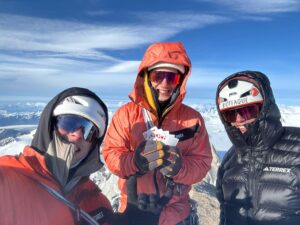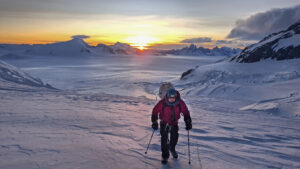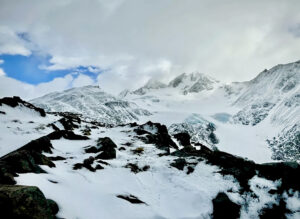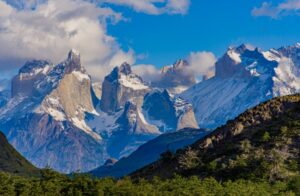Over the last month, Patagonian climbers have used favorable weather to nail good ascents on both Fitz Roy and Aguja Poincenot.
Fitz Roy and Aguja Standardt
Between Dec. 29 and 31, Austrian Laura Tiefenthaler and American Thomas Bukowski repeated the El Corazon route (1,250m, 45º, 6c, A3, M – 7b with variations) on Fitz Roy. Swiss Kaspar Ochsner and Czech Michal Pitelka first ascended the route via the east pillar of the tower on Feb. 20, 1992.
El Corazon was named after a heart-shaped feature high on the route, in a crucially difficult section.
Tiefenthaler and Bukowski arrived at the climbing area on Dec. 15. First, they did the Festerville route on Aguja Standardt, with navigation help from Patagonian master Rolo Garibotti. During the rappel down, they realized that the route had practically transformed into a waterfall.
“[An] intense first window…which we tackled already tired from traveling,” Tiefenthaler said. “Long, challenging days with scary warm conditions on the snowy and icy parts.”

Laura Tiefenthaler (left) and Thomas Bukowski during their expedition. Photo: Thomas Bukowski
The east face
Next, the duo headed to the east face of Fitz Roy. Tiefenthaler wrote of a “ill-defined weather window,” that kept changing with every update. Everything indicated that the weather would be windy and warm.
They targeted the east face because it was drier and more sheltered from the wind. The east pillar route is also handy in case you need to turn around, and the pair started their ascent without expecting to summit.
On Dec. 29, Tiefenthaler and Bukowski hiked to Paso Superior. They stayed there, hoping for safer and easier glacier conditions the next morning. On Dec. 30, they started hiking at 6 am. They crossed the difficult bergschrund at about 8 am, then had trouble finding the start of the route. They could see the crack they were aiming for but couldn’t get to it. However, at about 1 pm, Tiefenthaler and Bukowski eventually found the right line.
At 8 pm, they made it to the top of pitch 12 and just after midnight, they reached a ledge at pitch 16. But the ledge proved smaller than they expected, and Tiefenthaler only managed 10 minutes of sleep.

Ascending Fitz Roy. Photo: Laura Tiefenthaler
At 7 am, they continued up, arriving at the pendulum/slab below the heart-shaped rock scar at 3:30 pm.
“Negotiating this section worked out well, thanks to the perfect beta we got from Colin Haley,” Tiefenthaler said. At 9:45 pm, they stopped for a little rest and received a forecast from Garibotti detailing 45kph winds at the summit between 3 am and 6 pm, with worse weather after.
Little margin for error
Tiefenthaler took over the lead for the last few pitches and mixed terrain to the summit. Tiefenthaler recalls that, although it worked out, there was little margin for error. “Usually I prefer to keep the decision-making on the more conservative side,” she said.
The protected east face plan had paid off, but at the shoulder, they were exposed and experienced windy gusts and visibility of only 15m. Route finding became tricky.
The pair reached the summit at 3 am on Jan. 1 and started down immediately. “We were both scared by the conditions, but we managed to stay very calm,” Tiefenthaler said.

Laura Tiefenthaler on the summit of Fitz Roy. Photo: Thomas Bukowski
However, during the climb, they had not slept enough. As they descended, they started to feel the effects, slowing down and feeling lethargic. After three stuck ropes on the long overhanging rappels, they had to cut one.
The two climbers reached La Brecha in mid-afternoon and arrived at Paso Superior at 7 pm. Unfortunately, they found out that the wind had blown away their tent. With no food or anywhere to rest, they walked back to El Chalten in strong wind and heavy rain.
“Our little outing from Paso Superior to El Chalten had taken over 70 hours with what felt like 15 minutes of sleep. Disaster mode as its best,” Tiefenthaler said. “It left me feeling properly tired.”

The El Corazon route. Photo: Laura Tiefenthaler
“Infinite splitters, 70-hour pushes, magical sunrises, debilitating cold, fear of death, cut ropes…too much happened to fit into an Instagram post,” Bukowski wrote on social media. “This adventure breaches a new level of alpinism for me.”
The first ascent of the east pillar of Fitz Roy, by Ochsner and Pitelka in 1992, used extensive fixed ropes during a two-month climb. Argentinians Carlos Molina and Inaki Coussirat repeated the route in 2013.

The route up on Aguja Poincenot. Photo: Kuba Kokowski
Aguja Poincenot
Polish climbers Kuba Kokowski and Michal Czech also made good use of the weather window at the end of December. From Dec. 29 to 31, they climbed Aguja Poincenot from the hard-to-reach north side. They did a variant of the 40º Gruppo Ragni di Lecco route (6c, 700m, plus 300m to the top).
Kokowski and Czech approached the Polish Camp on Dec. 29. Trekking to the camp took 8 to 10 hours and required 1,500m of elevation gain. The 22km trek led through a difficult glacial area without a designated path.

Kokowski on the key headwall, a 55m splitter (6c) on Aguja Poincenot. Photo: Polski Himalaizm Sportowy
At dawn on Dec. 30, the duo set off for the wall, which took about five hours. The approach could be considered a separate route, with about 1,000m of elevation, including 100m of IV-V rock of poor quality. Part of the approach runs under a hanging serac.
At 11 am, the climbers started their line. At the fourth pitch, they accidentally deviated from the route, marking out five of their pitches with difficulties up to 6c in very good quality rock.
Around nightfall, Kokowski and Czech returned to the right route and set up an inconvenient camp after 12 pitches.
At 8 am on Dec. 31, the duo started again. Shortly before 1 pm, the team finished climbing the 40º Gruppo Ragni route. From there, they topped out at 3 pm after a further 300m.

Michal Czech on the summit of Aguja Poincenot. Photo: Polski Himalaizm Sportowy
Good weather and good rock
They descended from the summit via the Carrington-Rouse route. After one more bivouac, they reached the Polish camp, and later the same day, they continued to El Chalten. During the descent, falling rocks cut some of their ropes. The conditions were good, with very little ice on the wall. The climbers reported good quality rock.

Descending by the Carrington-Rouse route. Photo: Polski Himalaizm Sportowy
The 40º Gruppo Ragni di Lecco route on the north face of Aguja Poincenot was established in 1986 by Mario Panzeri, Paolo Vitali, Marco Della Santa, and Daniele Bosisio. It was first repeated by Italian climbers Matteo Della Bordella, Matteo Pasquetto, and Matteo Bernasconi in 2020. Sadly, a few months later, Pasquetto and Bernasconi died in different mountaineering accidents in the Alps.






